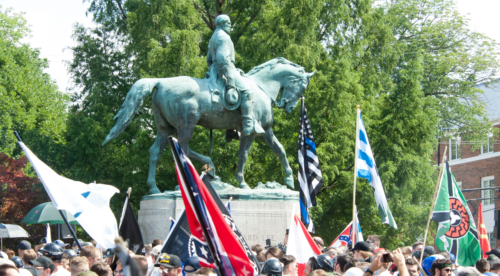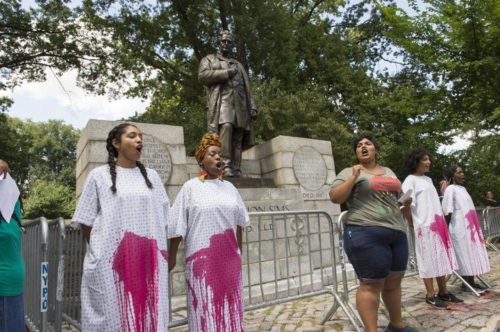Whose Heritage? Public Symbols of the Confederacy
Share
Explore Our Galleries
Breaking News!
Today's news and culture by Black and other reporters in the Black and mainstream media.
Ways to Support ABHM?
Report from the Southern Poverty Law Center
The Civil War ended 153 years ago. The Confederacy, as Mitch Landrieu said, was on the wrong side of humanity. Our public entities should no longer play a role in distorting history by honoring a secessionist government that waged war against the United States to preserve white supremacy and the enslavement of millions of people.
It’s past time for the South – and the rest of the nation – to bury the myth of the Lost Cause once and for all.

The Unite the Right Rally in Charlottesville focused on the removal of a Confederate statue honoring Robert E. Lee. Credit: Jackie Zimmerman
The 2015 massacre of nine African Americans at the historic “Mother Emanuel” church in Charleston sparked a nationwide movement to remove Confederate monuments, flags and other symbols from the public square, and to rename schools, parks, roads and other public works that pay homage to the Confederacy.
Yet, today, the vast majority of these emblems remain in place.
In this updated edition of the 2016 report Whose Heritage?, the SPLC identifies 110 Confederate symbols that have been removed since the Charleston attack – and 1,728 that still stand.
Many of these monuments are protected by state laws in the former Confederate states.

In August 2017, protesters demanded that the New York City Parks Department remove the statue of Dr. J. Marion Sims from its current location in Central Park. The statue was moved to Dr. Sims gravesite in Brooklyn in April 2018. DAILY NEWS
Others are shielded by civic leaders who refuse to act in the face of a strong backlash among many white Southerners who are still enthralled by the myth of the “Lost Cause” and the revisionist history that these monuments represent.
White supremacists have also taken up the cause, staging hundreds of rallies across the country to protest monument removals. We saw a dramatic display of their anger last August when hundreds of racists marched with torches and shouted Nazi slogans in Charlottesville, Virginia, where a young, anti-racist counterprotester was killed….
In New Orleans, a multicultural city steeped in Southern history, the political leadership took the opposite tack. In 2017, then-Mayor Mitch Landrieu powerfully defended the city’s removal of three prominent monuments and denounced the “false narrative” promoted by the “Cult of the Lost Cause.” That cult, he said, “had one goal – through monuments and through other means – to rewrite history to hide the truth, which is that the Confederacy was on the wrong side of humanity.”
We encourage communities across the country to reflect on the true meaning of these symbols and ask the question: Whose heritage do they truly represent?
Read the executive summary here and the full report here.
Read more Breaking News here.











Comments Are Welcome
Note: We moderate submissions in order to create a space for meaningful dialogue, a space where museum visitors – adults and youth –– can exchange informed, thoughtful, and relevant comments that add value to our exhibits.
Racial slurs, personal attacks, obscenity, profanity, and SHOUTING do not meet the above standard. Such comments are posted in the exhibit Hateful Speech. Commercial promotions, impersonations, and incoherent comments likewise fail to meet our goals, so will not be posted. Submissions longer than 120 words will be shortened.
See our full Comments Policy here.